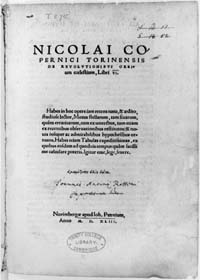Copernicus and Astronomical Tables
 Under the title, the Nuremberg printer Petreius exhorts a potential buyer as follows: Diligent Reader. ...You have the most convenient tables from which you will be able to compute those motions with the utmost ease for whatever time. Therefore, buy, read, and enjoy!
Under the title, the Nuremberg printer Petreius exhorts a potential buyer as follows: Diligent Reader. ...You have the most convenient tables from which you will be able to compute those motions with the utmost ease for whatever time. Therefore, buy, read, and enjoy!
Image by kind permission of the Master and Fellows of Trinity College Cambridge.
Thus, Erasmus Reinhold (1511-53), a mathematics lecturer at Wittenberg, re-calculated afresh from Copernicus' basic parameters a new set of astronomical tables. This was the Prussian Tables (1551), dedicated to Albert, Duke of Prussia and Margrave of Brandenburg. [image here: Title page from Erasmus Reinhold, Prussian Tables, 1551] Throughout his explanatory canons, Reinhold used as his paradigm the position of Saturn at the birth of the Duke of Prussia. He added redundant tables to his new tables so that compilers of almanacs familiar with the older Alfonsine Tables could perform all the steps in an analogous manner. The Prussian Tables, however, were a conservative replacement in the sense that it retained the very nature and function of an astronomical table, its astrological use. Reinhold had intended to follow this up with an astrological manual, which was never completed. For nationalistic and confessional reasons, the Prussian Tables became popular in German speaking countries. It is mainly through these tables that Copernicus's reputation was established as a skilled mathematician or an astronomer on a par with Ptolemy. It should be noted, however, that Copernicus did not win the hearts of European astronomers overnight: several tables based on the older, Alfonsine Tables were published after the publication of the Prussian Tables.